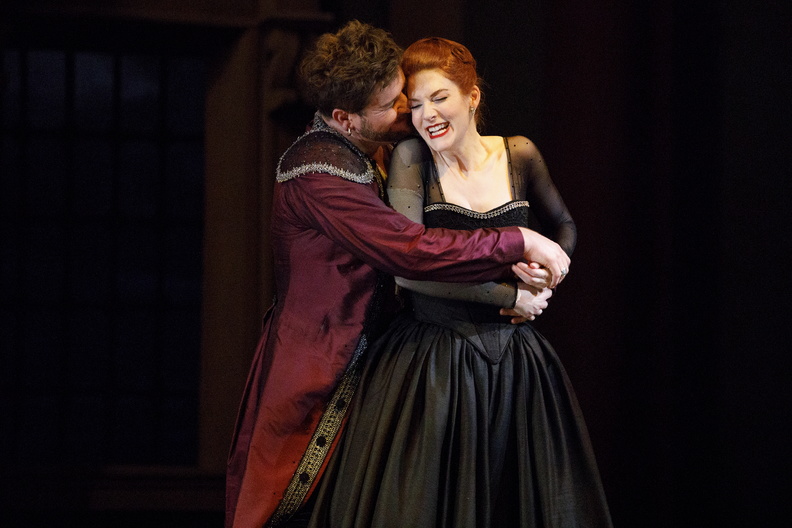Claudio Monteverdi’s presence on the Venetian opera scene was sorely missed. The eminent civic composer and madrigalist had not penned a new opera since debuting his ground-breaking L’Orfeo and L’Arianna in Mantua some 30 years earlier. The artistic community of La Serenissima was clamouring for a new work. The 1640 Lenten season was approaching and with it, Carnivale, traditionally a time for lavish performance pieces. Still Monteverdi demurred.
Why he resisted remains the source of some considerable speculation to this day. Creative circumstances could not have been more tantalizing from the point of view of time and place. Opera in mid-17th century Venice was a growth industry. Essentially turning their backs on dramma per musica’s genteel origins as a refined, aristocratic diversion, the hard-headed impresarios of the Lagoon flung open their theatre doors to opera mercenaria. The paying public flooded in, patricians and cittadini alike. Shows regularly sold out. Audiences were reportedly wildly enthusiastic, outrageously raucous, fiercely impassioned.
Perhaps Monteverdi felt constrained by the dignity of his position as maestro di cappella at Venice’s historic Basilica di San Marco, resident director of music at the great Byzantine duomo since 1613. Perhaps the weight of his advancing years — 73 before the lure of opera was finally to consume him again — had made him hesitate before plunging into a fresh, undoubtedly exhausting project. Whatever the reason, when precocious poet/librettist/intellectual Giacomo Badoaro delivered a recently penned manuscript copy of his self-adapted Homeric action thriller, Il Ritorno d’Ulisse in Patria (The Return of Ulysses) in 1639, Monteverdi’s stubborn resistance promptly crumbled. The maestro’s imagination exploded. Like his epic hero, Monteverdi was back.
Celebrating its 32nd season of landmark period performance, Opera Atelier showcases Monteverdi’s stormy masterpiece with a swirling, dynamic production churning with vitality. This, the company’s second Return of Ulysses — the first unveiled in 2007 — is nothing less than early opera defined, an irrepressible celebration of Baroque music theatre in all its intoxicating glory, exuberant, flamboyant, unfailingly resplendent.
Extracted more or less intact from the last eleven books of Homer’s Odyssey, Monteverdi spins a turbulent operatic tale. Virtually all the pre-existing beats are present.
Ulysses’ once noble court is in the grip of debauched would-be claimants. Valiant wife Penelope battles to retain her honour and independence, her husband long absent in the wake of endless seaborne adventures following the Trojan War. Twenty years have passed. Son Telemachus is wracked with feelings of powerlessness. The gods have not been kind. Neptune unleashes a savage storm. Much to his amazement, Ulysses finds himself shipwrecked on his native island shore of Ithaca, all-powerful Minerva in command of his destiny. Inspired by the goddess, Penelope vows to wed whomever of her suitors can string Ulysses’ mighty bow. A ragged beggar arrives at the palace. He alone possesses the requisite strength. A deadly flight of arrows. The suitors are slaughtered. Ulysses sheds his disguise. A family is reunited.
Assembling a fine, gifted cast of 12 superb singer actors inhabiting some 20 discrete roles, director Marshall Pynkoski ignites the theatrical fireworks, charging this Return of Ulysses with enormous power, substance fuelling style, myth energizing mise en scène. Though still highly dependent on Monteverdi’s bold artistic values to drive the fundamentals of hyper-narrative — Badoaro would later confess he could find little evidence of his text in the composer’s redrafts — Pynkoski and company polish and refine.
The Return of Ulysses is an opera of opposition. Extremes of emotion and situation, character and impulse relentlessly bend the action in and out of shape. Gods provoke mortals. Fidelity grapples with deceit. All is graphically revealed in Opera Atelier’s scrupulously nuanced presentation. Penelope literally pushes back against the suitors, struggling to keep them at palpable arm’s-length. Ulysses slips in and out of character as masquerading beggar, absent-minded shuffling gait, over-exaggerated stoop, testament to his unaccustomed awkwardness as an agent of divine will. Directorial insights are acute.
Uplifting and expanding The Return of Ulysses’ vibrant story arc, choreographer Jeannette Lajeunesse Zingg splashes the evening with enchantment, soloists and members of Opera Atelier’s corps de ballet tirelessly captivating, singers themselves frequently joining in. The fusion of Baroque ballet and drama is thoroughly seamless. The closing finale-come- curtain call finds the entire troop of assembled Ithacans all circling to the interpolated motif music director David Fallis has added to Monteverdi’s imperfectly preserved score. Capped by a charming pas de deux danced by vocalists Isaiah Bell and Carla Huhtanen, the moment, like innumerable other instances of singer actor multi-tasking, utterly delights.
This is a production broadly experienced, as sensual as it is spectacular. Baroque special effects — wind and thunder and godly portents — abound, lighting designer Michelle Ramsay’s strobes adding startling flashes of menace to her otherwise picturesque play of light and shadow. Costume creator Michael Legouffe adds his own share of affective design notes, a velvety ocean blue robe for Neptune, gleaming ghostly white satin gown for Minerva, the royal court in flamboyant technicolor. Set designer Gerard Gauci’s vivid painted backdrops reinforce the prevailing dream-like atmosphere.
With the bulk of the primary action concentrated extreme downstage, orchestra scarcely a heroic stride away from the proceedings above, characters seem almost to float on a stream of sensation, Monteverdi’s music billowing up beneath them. The effect is profoundly magical.
The Return of Ulysses marks a turning point in the evolution of Western opera. Although not always strictly delineated by Monteverdi, sung speech often elevated to the status of arioso, the notion of dividing vocal expression into double columns, expository recitative vs. lyrical aria, was to become a compositional benchmark for over 200 years.
Recreating the tremulous quality of opera on an historical knife edge, conductor David Fallis, in partnership with a brilliant 16-player ensemble courtesy Tafelmusik, strikes to the very core of genius, summoning all the colour and texture of Monteverdi’s daring score. Continuo is central here, a bright sonic foreground, resonant and harmonious. Leading from chamber organ, Fallis oversees substantial forces — twin harpsichords, double lutes, harp and guitar; strings, flutes and percussion providing additional upsweep. The consort’s taut, exquisitely sensitive handling of the little sinfonia that serves as a quasi overture, reprised several times as an orchestral motif during the ensuing Prologue, sets the tone for the entire evening.
Appearing in the title role of the legendary wanderer struggling to escape the snare of shifting fate, Croatian tenor Krešimir Špicer thrills, his captivating, self-assured stylings and ringing Italianate timbre reflecting all the daredevil dash of the legendary protagonist. O fortunato Ulisse, Špicer trills in a stupendous rendition of Monteverdi’s great coloratura aria — one of the very first of its kind. The suppleness and power of this voice is remarkable.
Mezzo-soprano Mireille Lebel sings a brave, resolute Penelope, a woman of towering conscience poised at the tipping point of collapse. Her anguished plaint that opens Act I, Di misera Regina non terminati mai dolenti affani! (“For a miserable queen there is no end to insufferable anxiety!”), a ravishing example of early recitative pressed to the outer limits of inner expression, tears at the heart. Torna, deh, torna, Ulisse! (“Return, oh, return, Ulysses”), cries Lebel, hands clenched, eyes glistening, seething with emotion. A shattering performance, simultaneously vulnerable and intense.
Tenor Kevin Skelton, countertenor Michael Taylor and bass-baritone Douglas Williams are venal suitors, Anfinomo, Pisandro and Antinoo. Broadly ranged, distinctively pitched, each endowed with more than ample vocal heft, the swaggering trio makes for a deliciously villainous ensemble. Shouldering the bulk of the purely actorly assignments as moral miscreant in chief, Williams turns in a particularly strong performance as a smouldering, muscled seducer. Scenes with Penelope sizzle.
Soprano Carla Huhtanen is Penelope’s duplicitous maid, Melanto. Tenor Isaiah Bell is her lusty lover, Eurimaco, a decidedly less than model servant to the suitors. The pair’s Act I assignation, musically embodied in Monteverdi’s luscious, sensuous duet, Dolce mia vita sei (“You are my sweet life”) is inexpressibly gorgeous. As wicked and treacherous as their characters may be, Huhtanen and Bell sing like angels.
As Minerva, soprano Meghan Lindsay gifts The Return of Ulysses with some of its most resounding moments of declamation, her pale, spectral presence chillingly haunting; her voice, a divine luminescent force. Bass-baritone Stephen Hegedus rises from the depths as fellow deity, blustery, thundering Neptune.
Tenor Aaron Sheehan is Ulysses’ plain spun ally, the shepherd Eumete. Fellow tenor Christopher Enns is a distraught Telemaco. Singing a finely gauged character role, mezzo Laura Pudwell turns in an endearing cameo performance as the bustling old palace retainer, Ericlea.
Monteverdi’s operatic output was modest, roughly ten known works in all of which only three survive in anything resembling credibly authentic form. The Return of Ulysses —original score unlocated, music somewhat in tatters — still shines across the ages. “Opera never got better than this,” director Pynkoski remarked in a brief encounter at one of Opera Atelier’s final rehearsals. Given the vibrancy and zest of this sprawling, rambunctious production, few could disagree.
* * *
Above: Krešimir Špicer as Ulysses, Mireille Lebel as Penelope. Photo by Bruce Zinger


